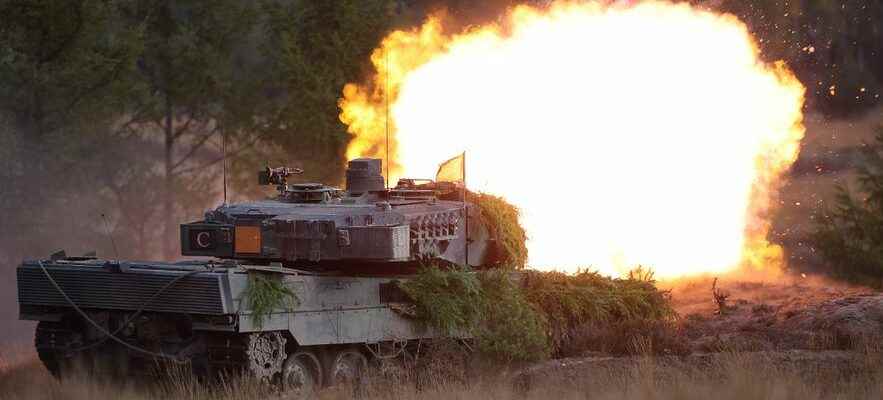After months of dithering, Westerners have finally taken the plunge. By giving the green light on Wednesday to the transfer of its Leopard 2s to Ukraine after an unlikely showdown with its allies, Germany ended an eleven-month taboo on sending modern combat tanks to Ukraine. In addition to the 14 copies provided by Berlin, should quickly be added those promised by several European countries ranging from Poland to Norway, via Spain. A long-term victory for Ukraine, which has been asking for them since March. On the other side of the Atlantic, the United States took action the same day by announcing the forthcoming delivery of 31 M1 Abrams.
“This is a turning point for Ukraine because these are much more modern, powerful and accurate tanks than their Russian counterparts currently deployed. I would not like to be a Russian tanker who finds himself confronted with a Leopard 2, delivers General (2S) Jérôme Pellistrandi, editor-in-chief of the Revue Défense nationale. Now, the real problem will be quantity: because you need a lot of leeway to have a military effect on the ground.” In December, the commander-in-chief of the Ukrainian armed forces estimated its needs at 300 armored vehicles. Including the 14 Challenger 2s already announced by the British on January 14, more than a hundred machines should quickly fill the Ukrainian arsenal. To complete the picture, Warsaw announced on Friday adding 60 PT-91 tanks, a modernized version of the Soviet T-72 tank, to the 14 Leopard 2s promised a few days earlier.
Designed to outclass Soviet tanks
On the Russian side, the reaction was not long in coming. “In Moscow, we see this as a direct engagement in the conflict and we see that this engagement is growing,” Russian presidential spokesman Dmitry Peskov told reporters on Thursday. In the game of comparisons, Russian equipment pales in comparison. “We must remember that Western tanks were designed in the 1980s to fight and outclass Soviet tanks, underlines General Dominique Trinquand, military expert and former head of the French mission to the UN. Their firepower is assured by extremely powerful 120 mm guns, and their 1,500 horsepower under the hood give them great mobility.The armor of Western tanks is also superior to that of the Russians: their weight approaches 60 tons where the Russian tanks are rather around 40 to 50 tons.”
A German Leopard 2 tank during an exercise in Ostenholz, northern Germany, in October 2022
© / afp.com/Ronny Hartmann
Beyond their performance, these armored vehicles are also a welcome contribution to restocking a Ukrainian fleet that has been sorely tested by nearly a year of conflict. According to the independent site Oryx, kyiv has lost at least 450 tanks since the start of the war.
Combined effects
On the tactical level, the use of these modern tanks, combined with the previous equipment sent by the West, could prove to be particularly interesting for the Ukrainian forces. “Ukraine should be able to carry out a real combined arms combat in the spring, that is to say, to use artillery, infantry and armored vehicles, which operate in unison”, abounds François Heisbourg, special advisor to the Foundation for Strategic Research.
A configuration in which the French AMX-10 RC light tanks, but also the American Bradley and German Marder infantry fighting vehicles, could provide valuable support to the heavy tanks. “The AMX-10 RC could scout ahead, followed by a mix of modern combat tanks and infantry fighting vehicles capable of conquering terrain quickly, illustrates General Pellistrandi. The ability of the Ukrainian command to use combined effects of these different materials will be decisive in making the difference.”
What will allow Ukraine to relaunch offensive operations, after its first successes recorded in the Kharkiv region in September, then in Kherson in November? “The Ukrainian forces have been looking to mount a new maneuver for a long time, but did not have the means. These new tanks will help them, judges General Trinquand. One of the targets of choice could be to descend towards the sea of ‘Azov to split the Russian force in southern Ukraine in two.’ And cut off all land connections between Crimea and Donbass.
A number of challenges remain for the Kyiv forces. “These are complex tanks that require extremely rigorous logistics, and more important than many other materials currently deployed,” summarizes General Pellistrandi. The training of crews on these state-of-the-art systems is a second major challenge. “It takes time, continues the senior officer. But since the beginning of the war, the Ukrainians have been able to be very resourceful in this area.”
